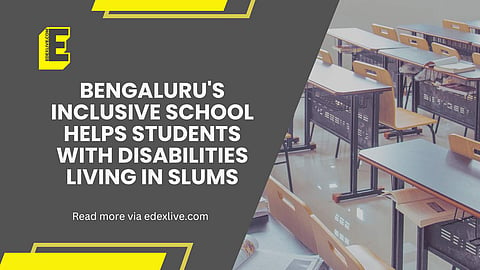

Even before the concept of inclusion became popular, for the past 50 years, a small school in Lingarajapuram is working towards changing the lives of disabled children from slums, and empowering them to become independent individuals, stated a report in The New Indian Express.
A woman, whose child has Global Developmental Delay (GDD), told The New Indian Express: “I have seen a lot of improvement in my eight-year-old daughter; improvements in her physical health and social skills. I have tried multiple organisations, but they only had therapy.”
More about the school
Shradhanjali Integrated School (SIS) has a ratio of 80 per cent disabled children, and 20 per cent abled children, 313 students for 2023-24. Following the state curriculum (SSLC Board), the institution has customised its learning for the kids, at a subsidised cost. The school focuses on activity-oriented learning, sports, art and craft to ensure all-round development. Earlier, the school was operational only till Class VII, and from the current year, Class 8 has been introduced, which will be followed by Classes IX and X the following year.
Committed to the cause of the Association of People with Disability (APD), under which the school runs, SIS has students with 11 different disabilities, including autism, hearing issues, developmental disability, down syndrome, locomotor disability, and many more.
“There are in total 35 students who have speech and hearing impairment. For this, every classroom has a translator to help them understand the concepts better and feel included,” SIS Principal Pannaga Babu said.
Dismissing remedial methods, the teachers at SIS opined that in other schools, disabled students are excluded and pulled out of the classroom “to focus more on them”, but this causes more harm than good.
As most of the children at SIS come from financially weaker sections, facilities like mid-day meals, books, uniforms, healthcare, rehabilitation, transportation, and adapted learning techniques are provided to supplement their academic inputs. In fact, to help the children, the school has 10-12 wheelchairs in all buses to help students commute better.
The institution wants the students to “see themselves as people who can contribute to society". “To lead by example, we have several teachers who are disabled and have been contributing to the school,” the principal added.
Completely funded through donors and CSR grants by companies, the school aims to bridge the education gap. “The world's disability has increased by 15 per cent. We need more inclusive schools,” emphasised Pannaga. Currently, the staff is at a ratio of 1:20, but officials said to facilitate good education to students, they need at least a 1:8 ratio.
